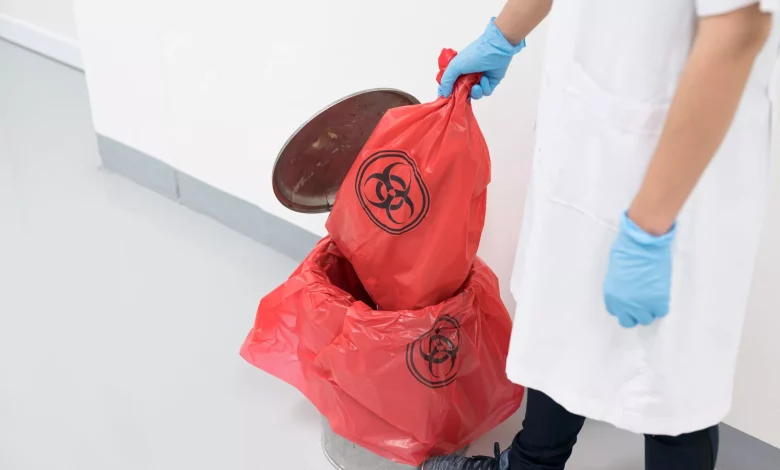An Overview Of The Olden Days Medical Waste Disposal Defined

Modern day practices recognize the necessity for properly disposing of the clinical waste; however it wasn’t always the case.
Imagine a society in which the waste generated by our daily life was not dealt with. Clean air and clean water were, at one time, essential resources weren’t always the same in the way they are now.
If you glance at the brief review of the past history surrounding medical waste disposal removal you’ll observe how far we’ve achieved progress in making the world an environment that is healthier and more secure for everyone.
Key Messages
Cleanliness is crucial to halt the spread of infection, especially in areas where there are workers since the accumulation of dust; dirt as well as microbes that are deposited on the surfaces could increase the spread of the infections.
Health care facilities and other health facilities must adhere to general guidelines for cleanliness.
Some Facilities Require Specialised Cleaning Procedures.
It is also crucial in fighting the spread of. Different kinds of waste – general, medical, and pharmaceutical wastes – each have their own method for disposal, which have to be followed.
The Beginnings Of Medical Waste Disposal
At the beginning of 1900, sanitation and the disposal of medical waste were not thought of at all. It wasn’t until the middle to late 1800s when things started to change.
The famous British reformer Edwin Chatwick, researched the awful conditions of the British prisons and hospitals. His work was pivotal to the creation of the Public Health Act in 1848. Chatwick’s work has inspired many other people.
Additionally, hospital waste disposal owes some credit to Joseph Lister, also from England. Lister found connections between modern germ theory concepts and the concept of sanitation as a way to assist in the treatment of medical patients.
In The Twentieth Century
The growth in the usage of medical waste in the 20th century led to Americans getting older. The advancements in technology and the stricter laws regarding hygiene were vital elements in helping people live longer, healthier lives.
Modern technology and improved standards were made law with the sharps bins that had yellow lids were made law in 1965 as well as the Medical Waste Tracking Act in 1988.
The more stringent regulations for hospital waste management was made an essential component that, in turn, brought benefits to the environment and led to healthier, happier life.
What Is The Definition Of Health Care Waste?
Healthcare waste includes the waste of all medical facilities including medical laboratories, biomedical research centres, as well as wastes from other minor or scattered sources.
Although hospitals are the most significant source of healthcare waste, in terms of the quantity, they only comprise a small fraction of the total quantity of sources.
The inadvertent management and disposal of healthcare waste could lead to serious risk of the transmission of secondary infections due to contact with infectious substances by workers, patients of waste pickers’ medical professionals, and all those living who work in the areas where waste isn’t properly.
Certain wastes can cause harm to anyone who comes into contact. This is why there are laws and regulations to regulate these types of wastes.
The term “clinical waste” refers to a variety of waste that
- A) It is a source of microorganisms or toxins they produce, which can cause sickness.
- B) Infected with any medicine that has bioactive pharmaceutical ingredients.
- C) is sharp, similar to needles, or is a reservoir for body fluids
Clinical waste is also a type of waste that is not from the healthcare industry. For instance, bins can contain female sanitary items found in bathrooms, public restrooms in hotels, restaurants and many other locations.
To ensure that you are in compliance with legal requirements, all clinical waste needs to be in a secure manner to ensure that any risk or threat is . The method of disposal of medical waste is in accordance with the law.
The Number Of Medical Wastes Does An Average Hospital Create?
An analysis of the disposal of yellow sharps bins rates around the world indicates that about 0.5 kg of waste per bed every day is by hospitals. But, this number and the type of garbage vary greatly depending on the local environment and income level.
The book offers a complete procedure for analysing local healthcare waste management production as well as the components of waste and disposal requirements, as well as identifying the most appropriate technology that can be used in an effective disposal system for waste.
What Kind Of Waste From A Medical Facility Is The Most Prone To Spreading Infectious Illnesses?
Healthcare waste is in accordance with the following categories of general classifications like Sharps, Pathological Waste, other toxic wastes, pharmaceuticals that include radioactive waste and cytotoxic waste and the general (non-risk) hazardous waste.
In general the range of 75 to 90 percent of the waste by hospitals is non-risk (non-infectious hazardous and hazardous) general waste that is similar to household trash. Infectious waste refers to a one that is to have pathogens (disease-causing bacteria, virus’s parasites, and fungal organisms) in sufficient quantity to cause illness in vulnerable hosts.
The Compendium Examines Segregation And Separate Treatment Of Waste In Medical Facilities. What Exactly Is Segregation?
Separation is an essential aspect of efficient medical waste disposal.
Other elements of managing waste from the healthcare sector include waste classification and minimization of waste containerization.
Colour-coding labels and signs, transportation handling storage, treatment and disposal. Naturally, to maintain a successful system is a continuous process that requires learning and budgeting.
What Can Countries Do To Establish A Waste Management Policy On Medical Waste?
The process of creating the right waste management program can be quiet .
It also includes an evaluation of waste, an evaluation of the current methods, a look at options for managing waste, and the creation of an overall waste management strategy and the promulgation of guidelines and guidelines, the formulation for a management body that allocates human and financial resources.
What Is The Reason We Should Focus On The Issue Of Clinical Waste?
There are many factors, some which are able to be with intervention from policy, whereas others aren’t, can be contributing factors to an increase in health spending and the amount like the expansion of populations.
This research brief offers evidence that points to the issue of offensive waste collection in clinical settings as a major driver of the increase in health expenditure in the US.
In this report, an estimate of the dollar value of waste, as well as its components. They have by the authors to percentages of the health care expenditure of the year in question.
Separation Guidelines And Regulations
Different kinds of offensive waste disposal within a medical facility require separation. The waste by clinical facilities must be by other types of garbage (paper and office equipment etc.).
Additionally, all types of clinical waste must be and into suitable categories. For instance, sharps need to be from other wastes like blankets and sheets which have .
For instance, there are containers specifically for the handling of sharps.
The containers are of the heavy red, puncture-proof, and puncture-plastic. They are with a biohazard label. Medical waste that’s not sharp should be in biohazard-safe trash bags with an identification label for biohazards.



